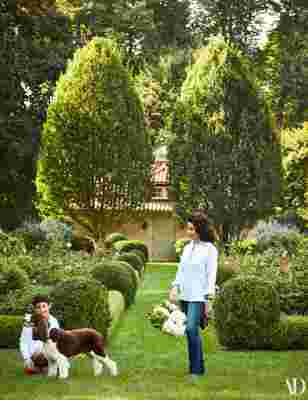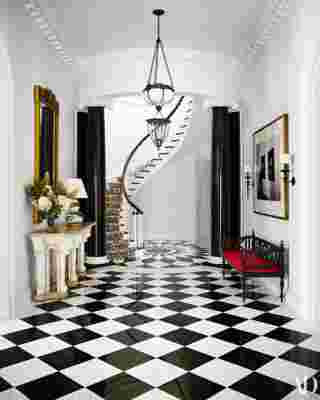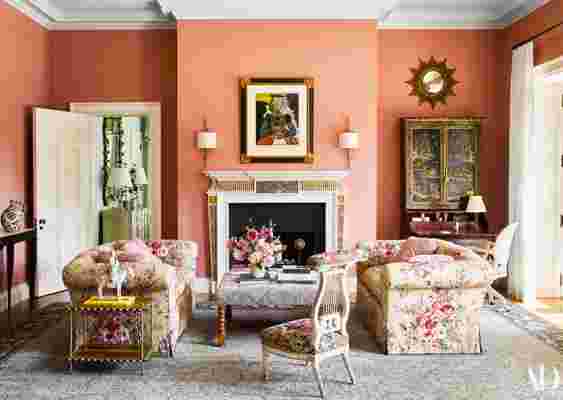Mary Ann Tighe will gladly tell you that she wasn’t to the manner born. “I’m a girl from the Bronx,” says the powerhouse New York commercial real-estate broker, who recently built a country manor dubbed Hollyhock with her husband, Dr. David Hidalgo, on four acres near the ocean in Southampton, New York. Located on the site of a former estate known as Red Maples, the new house has historical antecedents: The stucco exterior and Mission-tile roof allude to the original 1908 villa that was razed in the 1940s; the signature interior features were inspired by the iconic mansions that architect David Adler built in Chicago’s lakefront suburbs in the 1920s and 1930s.

Tighe and her grandson in the garden.
Sitting in the 55-foot-long, three-bay, pine-paneled library that was inspired by an Adler design, Tighe pulls out books on the architect and his sister, decorator Frances Elkins. “I forget where I saw it first, but I have always remembered it,” says Tighe, finding the pages with photographs of the library as well as the grand black-and-white marble foyer with an elliptical staircase (an Adler adaptation of a design by John Russell Pope), which she asked architect Michael Dwyer to duplicate. “This is a souped-up version of that library,” says Dwyer, who traveled with Tighe to Lake Forest, Illinois, to tour some of Adler’s houses. “Mary Ann wanted 14-foot ceilings, and we wanted to get the proportions right.”
As CEO for the New York tristate region of the global real-estate firm CBRE, Tighe is a professional matchmaker who brings together commercial landlords and high-profile anchor tenants. (She brokered the deal that brought AD’s parent company, Condé Nast, to its current One World Trade Center address.) When she assembled the team for her home—Dwyer, AD100 decorator Bunny Williams , landscape architect Quincy Hammond, and builder Frank Cafone—she had them collaborate on a new guesthouse first to make sure they worked well together under her direction.
In terms of decorating, we wanted to enhance the architecture because it’s so strong.
Tighe is a virtuoso dealmaker, but she doesn’t consider it an art form. Trained as an art historian, she worked in the White House as an arts adviser for vice president Walter Mondale and his wife, Joan, and then served as deputy chairman of the National Endowment for the Arts from 1978 to 1981. She left Washington, D.C., to join her husband in New York, where he was beginning his career as a plastic surgeon. She went to work for ABC to launch a cultural cable channel that would eventually become A&E, then became a broker in the mid-1980s.


Tighe was drawn to Williams, the grande dame of New York’s decorating establishment, because they are cut from the same cloth. “Bunny’s a businesswoman, and I knew she would operate meticulously and efficiently,” says Tighe. “She’s enormously practical. She’s a problem solver, and comfort is as important to her as beauty and elegance. She asks good questions: ‘Do you have a dog? Grandchildren? Do you have houseguests? Do you eat in the kitchen?’ ” (Yes. Yes. Occasionally. No.)In fact, Tighe and her husband never eat in the kitchen. “They eat in the dining room even if it’s just the two of them,” says Williams, explaining why she designed a relatively small dining table for the grand space with rare 19th-century hand-painted Chinese wallpaper panels set into the boiserie. (“There’s a top that can be put on the table if she has a large dinner party,” notes Williams.) The dining room is connected to the kitchen by a handsome blue-gray-paneled butler’s pantry, which is stocked with an extensive assortment of china and linens. “I love setting the table because I was deprived of dishes in my childhood,” says Tighe.
Williams and her associate Elizabeth Swartz embraced Tighe’s directions for the living room that overlooks an emerald lawn. “Mary Ann had seen Pride & Prejudice on television and saw blue walls that she wanted us to replicate,” says Swartz. “We took screenshots of it, but the color was different from every angle, so it took a long time to get it right.” The rich watery blue is the perfect backdrop for a large canvas by Abstract Expressionist Joan Mitchell that dominates one end of the room. “The painting really pops against the colored wall,” says Williams.
The use of color throughout the house is precisely modulated. “You need to know when to stop so the rooms aren’t overdone,” says Williams. “You need to think of balance.” On the second floor, a cream-colored hall leads to the massive upstairs sitting room with bracing sunset-pink walls. Furnished with sofas upholstered in muted floral chintz and Williams’s trademark mix of well-bred antiques, the space is cheerfully chic but not cloying.
Williams distilled the colors of the sky and gardens for the adjacent master suite with custom Peter Fasano blue-and-green-striped fabric for the walls and curtains and romantic floral linen from Lee Jofa for the upholstered bed. Tighe is especially fond of the ethereal lavender walls in her dressing room, where her grandson likes to sit on the chaise longue and chat with her when he isn’t playing in his toy-filled bedroom.
The tour of the property continues outside as Tighe strolls over to the two-bedroom guesthouse where she and her husband lived while the new house was being built. She passes the swimming pool to the back of the property where a newly built freestanding four-car garage containing some of her husband’s collection of 1960s sports cars is shaded by century-old trees. As she returns through a parterre garden to the motor court at the entrance to the main house, it’s obvious that one of the best deals she’s ever put together was brokering the harmonious partnership of Dwyer, Williams, Hammond, and Cafone. As Williams says, “Mary Ann was the orchestrator, and we were the players who produced the symphony.”
